Für US-Microcap-Aktien geltende Beschränkungen
Einleitung
Um den Vorschriften hinsichtlich des Verkaufs von nicht registrierten Wertpapieren gerecht zu werden und den manuellen Bearbeitungsaufwand auf ein Mindestmaß zu begrenzen, der mit dem Handel von nicht börsennotierten Aktien verbunden ist, nimmt IBKR Beschränkungen für bestimmten US-Microcap-Aktien vor. Im Folgenden stellen wir eine Liste dieser Einschränkungen sowie FAQs zu diesem Thema bereit.
Für Microcap-Aktien geltende Beschränkungen
- In Bezug auf US-Microcap-Aktien akzeptiert IBKR nur noch Transfers von Aktienpaketen zulässiger Kundinnen und Kunden. Kundenkonten gelten als zulässig, wenn sie: (1) ein Kapital von mindestens 5 Mio. USD (vor und nach dem Transfer) aufweisen oder von Finanzberatern verwaltet werden, die jeweils Vermögenswerte in Höhe von insgesamt mindestens 20 Mio. USD verwalten; und (2) wenn US-Microcap-Aktien weniger als die Hälfte des Kapitals ausmachen.
- IBKR wird Transfers von1 US-Microcap-Aktienpaketen nur dann akzeptieren, wenn der zulässige Kunde bzw. die zulässige Kundin bestätigen kann, dass die Aktien auf dem freien Markt erworben wurden oder bei der SEC registriert sind.
- IBKR wird Folgendes grundsätzlich nicht akzeptieren:1 Transfers von bzw. eröffnende Orders für US-Microcap-Aktien, die von OTC als „Caveat Emptor“ order „Grey Market“ klassifiziert wurden. In den Kundenkonten bereits vorhandene Positionen dieser Art können jedoch weiterhin geschlossen werden.
- IBKR akzeptiert keine Transfers von US-Microcap-Aktien, die dazu dienen, eine bei IBKR eingegangene Short-Position zu decken.
- IBKR-Konten mit dem Status „Execution-only“ (d. h. die Trades werden über IBKR ausgeführt, aber das Clearing dieser Trades findet nicht bei IBKR statt) dürfen nicht zum Handeln von US-Microcap-Aktien verwendet werden. (IBKR kann ggf. Ausnahmen für in den USA registrierte Broker gewähren.)
FAQs zu Microcap-Aktien
Was sind US-Microcap-Aktien?
Microcap-Aktien sind Aktien, die (1) außerbörslich (over the counter, OTC) gehandelt werden oder (2) an der Nasdaq oder NYSE American notiert sind, deren Marktkapitalisierung zwischen 50 und 300 Mio. USD liegt und die für maximal 5 USD gehandelt werden. Im Rahmen dieser Richtlinie werden Aktien von staatlichen Unternehmen der USA auch zu den Microcap-Aktien gezählt, deren Marktkapitalisierung unter 50 Mio. USD liegt, die auch als Nancocap-Aktien bezeichnet werden, oder die auf einem generell mit Microcap-Aktien assoziierten Markt gehandelt werden.
Um zu vermeiden, dass kleinere, kurzfristige Kurspreis-Schwankungen eine wiederholte Neuklassifzierung verursachen, bleiben US-Microcap-Aktien so lange als solche klassifziert, bis sowohl deren Marktkapitalisierung 300 Mio. USD als auch deren Kurspreis 5 USD überschritten haben – und zwar über einen Zeitraum von 30 aufeinanderfolgenden Tagen.
Da es sich bei Microcap-Aktien häufig um niedrigpreisige Aktien handelt, werden sie im Deutschen auch als Kleinstwerte und im Englischen als Penny Stocks bezeichnet. IBKR behält sich vor, Ausnahmen vorzusehen, z. B. für niedrigpreisige Aktien, deren Marktkapitalisierung bis vor Kurzem noch höher war. Darüber hinaus erachtet IBKR sogenannte Amercian Depositary Receipts (ADRs), also von US-Banken herausgegebene Hinterlegungsscheine für Aktien von Nicht-US-Unternehmen, nicht als Microcap-Aktien.
Wo werden Microcap-Aktien gehandelt?
Microcap-Aktien werden in der Regel auf dem OTC-Markt und nicht an nationalen Wertpapier-Börsen gehandelt. Sie werden häufig elektronisch von Market-Makern über OTC-Systeme notiert, z. B. über das OTC Bulletin Board (OTCBB) und von der OTC Markets Group verwaltete Märkte (OTCQX, OTCQB & Pink usw.). Ebenfalls in diese Kategorie fallen Aktien, die ggf. nicht börsennotiert sind und als „Caveat Emptor“, „Other OTC“ oder „Grey Market“ klassifiziert sind.
Außerdem erachten US-Regulierungsbehörden an der Nasdaq oder NYSE American notierte Aktien mit einem Kurspreis von maximal 5 USD und einer Marktkapitalisierung von maximal 300 USD als Microcap-Aktien.
Was geschieht, wenn ein zulässiger Kunde bzw. eine zulässige Kundin einen Transfer an IBKR veranlasst und eine oder mehrere Positionen darin Microcap-Aktien sind?
Wenn IBKR einen Transfer empfängt, der ein Microcap-Aktienpaket enthält, behält sich IBKR das Recht vor, den Verkauf von jeglichen Microcap-Positionen in diesem Transfer zu beschränken, es es sei denn, die Person, die den Transfer veranlasst hat, legt geeignete Belege darüber vor, dass die Aktien entweder auf dem freien Markt (d. h. an einer öffentlichen Börse über einen anderen Broker) gekauft wurden oder bei der SEC registiert sind (Formular S-1 oder einer ähnlichen Registrierungserklärung).
Zulässige Kundinnen und Kunden können belegen, dass die Aktien auf dem freien Markt erworben wurden, indem sie eine enstprechende Broker-Erklärung oder Trade-Bestätigung eines seriösen Brokers vorlegen, aus der hervorgeht, dass die Aktien an einer öffentlichen Börse gekauft wurden. Zulässige Kundinnen und Kunden können belegen, dass die Aktien registriert sind, indem sie das SEC-Aktenzeichen (Edgar-System) vorlegen, unter dem ihre Aktien von dem Unternehmen registriert wurden (sowie alle Dokumente, die erforderlich sind, um zu bestätigen, dass es sich bei den Aktien um die in der Registrierungserklärung genannten Aktien handelt).
HINWEIS: Es steht allen Kundinnen und Kunden jederzeit frei, Aktien jeder Art von ihrem Konto an ein anderes zu transferieren.
Inwieweit wird IBKR Prime-Konten beschränken?
Kundinnen und Kunden, zu deren Aktivitäten auch Prime-Services gehören, gelten als zulässig allein für die Zwecke dieser Handelsgeschäfte, da IBKR zugstimmt hat, diese von seinen ausführenden Brokern zu akzeptieren. Obwohl über Prime-Konten US-Microcap-Aktien bei IBKR abgewickelt werden können, werden diese Aktien so lange begrenzt, bis IBKR bestätigt hat, dass sie gemäß den oben beschriebenen Verfahren weiterverkauft werden können.
Um die Beschränkungen der auf dem freien Markt erworbenen Aktien aufzuheben, lassen Sie sich vom ausführenden Broker ein unterzeichnetes Schreiben auf Firmenpapier ausstellen oder reichen Sie einen offiziellen Kontoauszug ein, aus dem hervorgeht, dass die Aktien auf dem freien Markt gekauft wurden. Das Schreiben bzw. der Auszug muss auch die folgenden Kriterien erfüllen. Falls die Aktien im Rahmen eines Angebots erworben wurden, müssen dem Schreiben bzw. Auszug Dokumente oder Verweise hinzugefügt werden, die sich auf die jeweilige Registrierungserklärung beziehen und angeben, dass die Aktien Teil des Angebots waren.
Erforderlicher Inhalt und Anforderungen an das Broker-Schreiben:
IBKR-Konto-Nummer
2) IBKR-Konto-Bezeichnung
3) Handelstag
4) Settlement-Datum
5) Symbol
6) Handelsrichtung
Kurs
Menge
9) Uhrzeit der Ausführung
Börse
11) Unterzeichnet
12) Auf offiziellem Firmenpapier gedruckt
Zusammenfassung: Sell-Orders für Long-Positionen werden akzeptiert, wenn die Long-Position nicht mehr beschränkt ist. Sell-Orders für Short-Positionen werden akzeptiert. Buy-Orders für Long-Positionen werden akzeptiert und die Position wird so lange beschränkt, bis Compliance alle erforderlichen Informationen erhalten hat, um die Beschränkung aufzuheben. Buy-Orders für Deckungsgeschäfte und Roundtrip-Geschäfte (Ein- und Aussteigen) am selben Tag werden nicht akzeptiert.
Was geschieht, wenn eine bereits gekaufte Aktie später als „Grey Market“ oder „Caveat Emptor“ klassifiziert wird?
Wenn Sie mit Ihrem IBKR-Konto eine Aktie kaufen, die zu einem späteren Zeitpunkt als „Grey Market“ oder „Caveat Emptor“ klassifiziert wird, können Sie diese Position halten, schließen oder transferieren, jedoch nicht weiter aufbauen.
Aus welchen Gründen kann der Handel mit Microcap-Aktien für mein Konto eingeschränkt werden?
Es gibt zwei wesentliche Gründe, die zu einer Beschränkung des Handels mit Microcap-Aktien führen können:
- Mögliche Verbindung zum Emittenten: Die Rule 144 der U.S. Securities and Exchange Commission (SEC) gibt gewisse Einschränkungen für den Handel mit Aktien (einschließlich Microcap-Aktien) vor, wenn eine Verbindung („affiliation“) zum Emittenten besteht . Wenn IBKR auf Microcap-Handelsgeschäfte oder -Beteiligungen aufmerksam wird, die sich nah an den Schwellenwerten der Rule 144 („Rule 144 Thresholds“) befinden, wird IBKR für diese Person ggf. den Handel mit dieser Microcap-Aktie beschränken, bis eine Compliance-Überprüfung abgeschlossen wurde.
- Transferierte Microcap-Aktien: Bei einem Transfer von Microcap-Aktien in ein IBKR-Kundenkonto behält sich IBKR vor, den Handel mit diesem Wertpapier für dieses Konto zu beschränken, bis eine Compliance-Überprüfung abgeschlossen wurde.
Falls einer dieser Gründe zutrifft, wird der Handel mit diesem Wertpapier beschränkt und der Kunde bzw. die Kundin erhält eine Benachrichtigung über das Mitteilungscenter im Client Portal. In der Benachrichtigung wird der Grund für die Beschränkung angegeben und es wird erläutert, welche Schritte erforderlich sind, damit IBKR prüfen kann, ob die Beschränkungen aufgehoben werden können.
Warum denkt IBKR, dass eine Verbindung zwischen mir und dem Emittenten einer Microcap-Aktie bestehen könnte?
Eine Verbindung („affiliation“) ist dann gegeben, wenn es sich bei der Person um einen Executive Officer, Director oder großen Shareholder handelt und durch das Verhältnis somit die Möglichkeit der Einflussnahme besteht.
Rule 144 gilt für alle Wertpapiere und somit auch für Microcap-Aktien. Angesichts des erhöhten Risikos, das mit dem Handel von Microcap-Aktien einhergeht, wird IBKR jedoch den Handel mit einer Microcap-Aktie beschränken, wenn sich die Handelsgeschäfte und/oder Beteiligungen in einem Kundenkonto nah an den Schwellenwerten der Rule 144 („Rule 144 Thresholds“) bewegen. Diese Beschränkungen bleiben in Kraft, bis die Compliance-Abteilung geprüft hat, ob eine Verbindung zwischen Kontoinhaber/-in und Emittent bestehen könnte.
Warum muss die Prüfung auf eine möglichen Verbindung alle zwei Wochen wiederholt werden?
Ob eine Verbindung besteht oder nicht, kann sich kurzfristig ändern, nachdem IBKR die oben genannte Prüfung auf eine mögliche Verbindung abgeschlossen hat. Daher erachtet IBKR es als angemessen, die Prüfung auf eine mögliche Verbindung alle zwei Wochen zu wiederholen, falls sich die Micropcap-Handelsgeschäfte und/oder -Beteiligungen in einem Kundenkonto weiterhin nah an den Schwellenwerten der Rule 144 bewegen.
Wo finde ich eine Liste der Aktien, die IBKR als US-Microcap-Aktien erachtet?
Eine Liste der von IBKR als US-Microcap-Aktien erachteten Aktien ist hier verfügbar: www.ibkr.com/download/us_microcaps.csv
Diese Liste wird täglich aktualisiert.
Wo finde ich weiterführende Informationen zu Microcap-Aktien?
Weiterführende Informationen zu Microcap-Aktien, einschließlich zu den damit verbundenen Risiken, sind auf der SEC-Website verfügbar: https://www.sec.gov/reportspubs/investor-publications/investorpubsmicrocapstockhtm.html
-----------------------------------------------------------
1Dies gilt für alle Arten von Transfers (z. B. per ACATS, DWAC, FOP), die Umwandlung von kanadischen Listings in ihre US-Gegenstücke per „southbound” Transfer, Transfers zum Decken bestehender Positionen sowie Transfers von IB-Prime-Kundinnen und -Kunden, deren Orders von einem andern Broker und das Clearing von IBKR ausgeführt wird usw.
Locating your account number for ACATS transfers
In order for your ACAT or ATON transfer to be completed successfully, your broker must validate the account number provided on the request. If the account number is invalid, your broker will reject the request. IBKR recommends that clients review a copy of their brokerage statement to confirm their account number and has provided statement samples below from some of the more common brokers highlighting where this information can be found.
Charles Schwab - Broker #0164. Account Number convention is 8 characters, all numeric.
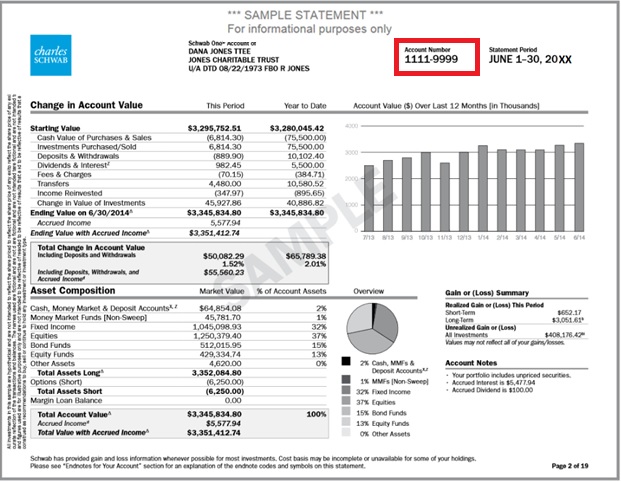
Fidelity Investments - Delivers through National Financial Services, Broker #0226. Account Number convention is 9 characters, first 3 alpha-numeric and last 6 numeric.
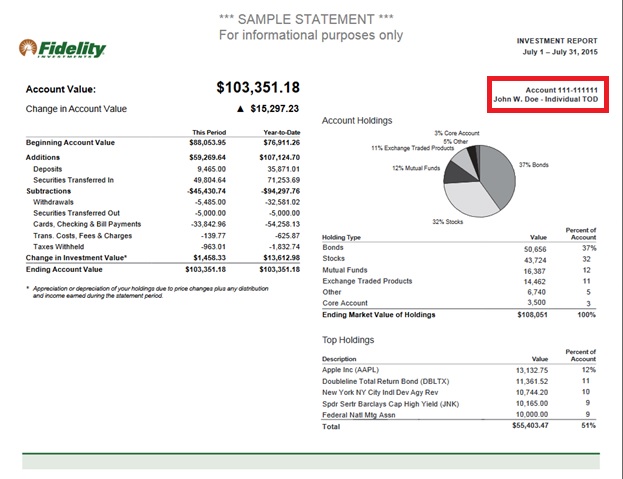
Merrill Edge - Broker #0671. Account Number convention is 8 characters, combination of alpha and numeric.
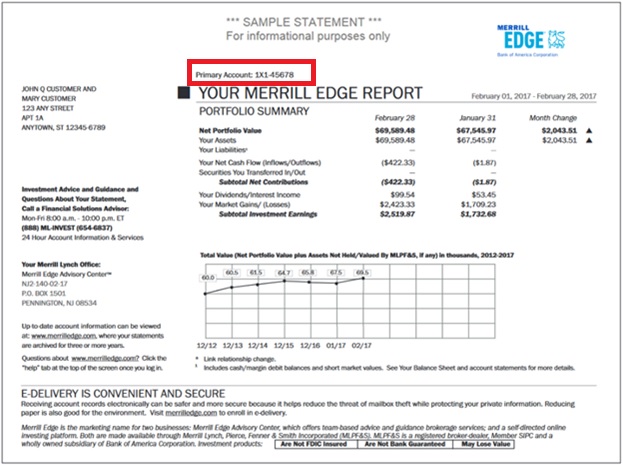
TD Ameritrade - Broker #0188. Account Number convention is 9 characters, all numeric.
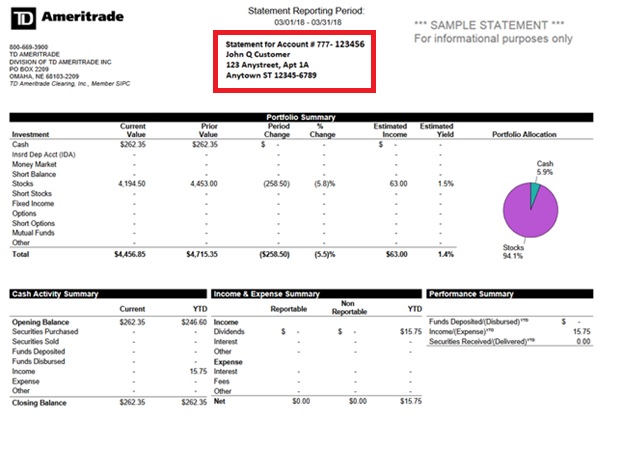
Vanguard- Broker #0062. Account Number convention is 8 characters, all numeric.
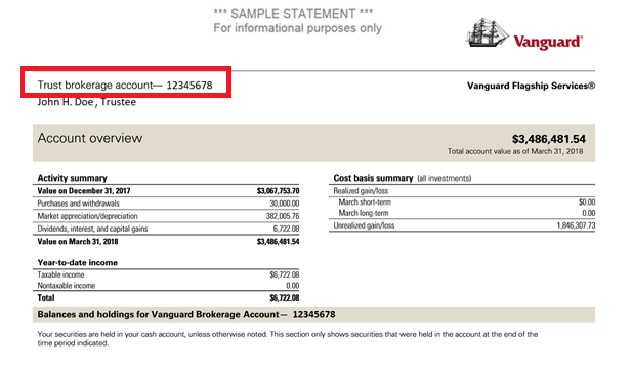
Note: This article contains images of sample broker statements which are for illustrative purposes only and which may contain logos that remain the property of each of those brokers.
U.S. Microcap Stock Restrictions
Introduction
To comply with regulations regarding the sale of unregistered securities and to minimize the manual processing associated with trading shares that are not publicly quoted, IBKR imposes certain restrictions on U.S. Microcap Stocks. A list of those restrictions, along with other FAQs relating to this topic are provided below.
Microcap Restrictions
- IBKR will only accept transfers of blocks of U.S. Microcap stocks from Eligible Clients. Eligible Clients include accounts that: (1) maintain equity (pre or post-transfer) of at least $5 million or, clients of financial advisors with aggregate assets under management of at least $20 million; and (2) have less than half of their equity in U.S. Microcap Stocks.
- IBKR will only accept transfers1 of blocks of U.S. Microcap Stocks where the Eligible Client can confirm the shares were purchased on the open market or registered with the SEC;
- IBKR will not accept transfers1 of or opening orders for U.S. Microcap Stocks designated by OTC as Caveat Emptor or Grey Market from any client. Clients with existing positions in these stocks may close the positions;
- IBKR will not accept transfers of U.S. Microcap Stocks to cover a short position established at IBKR;
- Execution-only clients (i.e., execute trades through IBKR, but clear those trades elsewhere) may not trade U.S. Microcap Stocks within their IBKR account. (IBKR may make exceptions for U.S.-registered brokers);
Microcap FAQs
What is a U.S. Microcap Stock?
The term “Microcap Stock” refers to shares (1) traded over the counter or (2) that are listed on Nasdaq and NYSE American that have a market capitalization of between $50 million to $300 million and are trading at or below $5. For purposes of this policy, the term Microcap Stock will include the shares of U.S. public companies which have a market capitalization at or below $50 million, which are sometimes referred to as nanocap stocks or trade on a market generally associated with Microcap Stocks.
To avoid situations where minor, short-term fluctuations in a stock price cause repeated reclassification, any stock classified as U.S. Microcap will remain in that classification until both its market capitalization and share price exceed $300 million and $5, respectively, for a 30 consecutive calendar day period.
As Microcap Stocks are often low-priced, they are commonly referred to as penny stocks. IBKR may make exceptions, including for stocks traded at low prices that recently had a greater market cap. In addition, IBKR will not consider ADRs on non-US companies to be Micro-Cap stocks.
Where do Microcap Stocks trade?
Microcap Stocks typically trade in the OTC market, rather than on a national securities exchange. They are often electronically quoted by market makers on OTC systems such as the OTC Bulletin Board (OTCBB) and the markets administered by the OTC Markets Group (e.g., OTCQX, OTCQB & Pink). Also included in this category are stocks which may not be publicly quoted and which are designated as Caveat Emptor, Other OTC or Grey Market.
In addition, U.S. regulators also consider stocks listed on Nasdaq or NYSE American trading at or below $5 with a market capitalization at or less than $300 million to be Microcap Stocks.
What happens if IBKR receives a transfer from an Eligible Client where one or more of the positions transferred is a Microcap Stock?
If IBKR receives a transfer containing a block of a Microcap stock, IBKR reserves the right to restrict the sale of any Microcap position(s) included in the transfer unless the Eligible Client provides appropriate documentation establishing that the shares were either purchased on the open market (i.e., on a public exchange through another broker) or were registered with the SEC pursuant to an S-1 or similar registration statement.
Eligible Clients can prove that shares were purchased on the open market by providing a brokerage statement or trade confirm from a reputable broker reflecting the purchase of the shares on a public exchange. Eligible Clients can establish that the shares are registered by providing the SEC (Edgar system) File number under which their shares were registered by the company (and any documents necessary to confirm the shares are the ones listed in the registration statement).
NOTE: All customers are free to transfer out any shares we have restricted at any time.
What restrictions will IBKR apply to Prime accounts?
Clients whose activities include Prime services are considered Eligible Clients solely for the purposes of those trades which IBKR has agreed to accept from its executing brokers. However, while Prime accounts may clear U.S. Microcap Stocks at IBKR, those shares will be restricted until such time IBKR confirms that the shares are eligible for re-sale under the procedures discussed above.
To remove the restriction for shares purchased on the open market, please have the executing broker provide a signed letter on company letterhead or an official Account Statement stating that the shares were purchased in the open market. The letter or statement must also include the below required criteria. Alternatively, if the shares were acquired through an offering the letter or statement must provide documents or links to the relevant registration statement and state that the shares were part of it.
Required Broker Letter Criteria:
1) IBKR Account Number
2) IBKR Account Title
3) Trade Date
4) Settlement Date
5) Symbol
6) Side
7) Price
8) Quantity
9) Time of Execution
10) Exchange
11) Must be signed
12) Must be on Firm's official letterhead
To summarize: Sell Long trades will be accepted if the long position is no longer restricted. Sell Short trades will be accepted. Buy Long trades will be accepted and the position will be restricted until Compliance is provided with sufficient information to remove the restriction. Buy Cover trades and intraday round trip trades will not be accepted.
What happens if a stock you purchase gets reclassified as Grey Market or Caveat Emptor?
If you purchase a stock in your IBKR account that at a later date becomes classified as a Caveat Emptor or Grey Market stock, you will be allowed to maintain, close or transfer the position but will not be able to increase your position.
What are some of the reasons why Microcap Stock trading may be restricted in my account?
There are two primary reasons why you might be restricted from trading in a Microcap Stock:
- Potential Affiliation to Issuer: U.S. Securities and Exchange Commission (“SEC”) Rule 144 places certain limitations on trading of stocks (including Microcap Stocks) by an “affiliate” of the issuer. If IBKR observes trading activity or holdings in a Microcap Stock that are close to the trading volume thresholds under Rule 144 (“Rule 144 Thresholds”), IBKR may restrict the customer from trading the Microcap Stock until a compliance review is completed.
- Transfer of Microcap Stock: If the customer has recently transferred a Microcap Stock into their IBKR account, IBKR may restrict the customer from trading in that security until a compliance review is completed.
If one of the above reasons apply, trading will be restricted in the security and a notification will be sent to the customer’s message center in Account Management. This notification will describe the reason for the restriction and the steps the customer must take before IBKR will consider lifting the restriction.
Why does IBKR consider me to be a potential affiliate of a Microcap Stock issuer?
An “affiliate” is a person, such as an executive officer, a director or large shareholder, in a relationship of control with the issuer.
Rule 144 applies to all securities, including Microcap Stocks. However, given the heightened risks associated with trading Microcap Stocks, if a customer’s trading and/or holdings in a Microcap Stock are close to the Rule 144 Thresholds, IBKR will restrict the customer’s trading in the Microcap Stock. This restriction will remain in effect pending a compliance review into the customer’s potential affiliate status.
For the Potential Affiliate review, why do I need to ask for a new review every two weeks?
A customer’s affiliate status may change soon after IBKR completes the above-referenced Potential Affiliate review. As such, IBKR believes it is appropriate to refresh a Potential Affiliate review every two weeks if a customer’s trading activity and/or holdings in the Microcap Stock remain close to the Rule 144 Thresholds.
Where can I find a list of stocks that IBKR has designated as U.S. Microcaps?
A list of stocks designated as U.S. Microcaps by IBKR is available via the following link: www.ibkr.com/download/us_microcaps.csv
Note that this list is updated daily.
Where can I find additional information on Microcap Stocks?
Additional information on Microcap Stocks, including risks associated with such stocks may be found on the SEC website: https://www.sec.gov/reportspubs/investor-publications/investorpubsmicrocapstockhtm.html
-----------------------------------------------------------
1This includes transfers by any method (e.g., ACATS, DWAC, FOP), conversion of Canadian listings to their U.S. equivalent via “Southbound” transfer, transfers to cover existing short positions, IB Prime customers executing with other brokers and clearing to IBKR, etc.
ACATS Transfer Guide (US brokerage account transfers)
ACATS Transfer Guide
Introduction
Understanding the basic facts about transferring accounts between US brokerage firms can be help to avoid delays. Through this article and other Knowledge Database resources, Interactive Brokers seeks to assist with your incoming and outgoing ACATS requests.
US brokerage firms utilize a standardized system to transfer customer accounts from one firm to another. Known as the Automated Customer Account Transfer Service or ACATS, the process allows assets to move seamlessly between brokerage firms in a unified time frame. ACATS transfers are facilitated by a third party, the National Securities Clearing Corporation (NSCC), to assist participating members with timely asset transfers.
ACATS Transfer Benefits
The majority of assets may be transferred between US brokerage firms and some banks through ACATS. This standardized system includes stocks, US corporate bonds, listed options, unit investment trusts, mutual funds, and cash. Information on assets eligible for transfer is provided at "Assets Eligible..." Though impacted by multiple factors and time constraints, the accepted or rejected transfers finalize within 10 business days in most cases.
Navigating The Process
4 simple steps of the ACATS process will help you understand the flow and minimize delays. Familiarizing yourself with the transfer process helps to ensure a successful transition.
1. Incoming or Outgoing
Incoming ACATS Transfers
The financial institution that is receiving your assets and account transfer is known as the "receiving firm." Investors always work with and through the "receiving firm" to move full or partial account assets into a new broker.
Contact the "receiving firm" (Interactive Brokers) to review the firm's trading policies and requirements. You should verify that your assets are eligible for trading at the "receiving firm" before initiating the transfer request. Not all ACATS transferable assets are acceptable for trading at every brokerage firm.
Outgoing ACATS Transfers
All outgoing ACATS transfers, full or partial, must be approved by the "delivering firm." Investors, however, should work with and through the "receiving firm" in order to begin the the transfer process or to status the progress of the request.
2. Initiating Your Transfer
Investors must always begin the ACATS transfer with the "receiving firm." An ACATS transfer form or Transfer Initiation Form (TIF) must be submitted. The "receiving firm" takes your reqeust and communicates with the "delivering firm" via ACATS. The process begins with this request for transfer of the account.
For your Interactive Brokers Account, the transfer is usually submitted online. Video instruction on submitting the transfer is provided at "How to deposit funds via a full ACATS/ATON Transfer." or through Step-by-step instructions.
Note: Outgoing account transfers from your IB account should be directed to the other broker. Your request will be submitted to IB from the other broker through the ACATS electronically.
3. What to Expect
Your Account
Brokers ensure the safety and security of transfer requests by only authorizing requests between open accounts that meet the following criteria:
- Same Account Title
- Same Tax ID Number
- Same Account Type
Transfer Approval
Ultimately responsible for validating the transfer, the "delivering firm" may accept information from the "receiving firm" correcting data originally entered. Approved or validated requests result in the delivery of positions to the "receiving firm" for their acceptance. Assets may not be accepted by the "receiving firm" for the following:
- Non-marginable or Margin (credit) violation
- Not Tradable
- DTC Chill
Note: The most common reasons for ACATS rejections are outlined by clicking here.
Processing Time-frame
The processing time for each transfer request is fixed. In general, approved transfers complete within 4 to 8 business days. Almost all transfers complete within 10 business days. Each firm is required to perform certain steps at specific intervals in the process. Feel free to review the Full ACATS transfer process flow.
Fees
While Interactive Brokers does not charge a fee to transfer your account via ACATS, some brokers do apply a fee for full and partial transfers. Prior to initiating your transfer, you should contact the "delivering firm" to verify any charge.
4. Who To Contact For Help
Interactive Brokers Customer Service stands poised to assist with your incoming ACATS transfer reqeust. Click here for Customer Service contact resources.
Note: Outgoing or ACATS transfers sending accounts to another broker should be directed to the "receiving firm." Their Account Transfer Group will work with Interactive Brokers directly to complete your outgoing request.
Free of Payment (FOP) Transfers
Free of Payment (FOP) is term used by IB to refer to a process of transferring long US securities between IB and another financial institution (e.g. bank, broker or transfer agent) through the Depository Trust Company (DTC).
The FOP transfer method is often used when:
1. The delivering form is not a DTC ACAT (Automated Customer Account Transfer) Participant.
2. The customer would like to expedite the delivery of their securities. The processing time frame for securities transferred via FOP may, in certain instances, be less than that associated with an ACATS transfer.
The following steps are to be followed in order to create a FOP notice:
1. Log into Account Management.
2. Select Funding or Funds Management and then Position Transfers.
3. From the drop-down list, select the Transfer Method: Free of Payment.
4. Select the applicable transaction Type: Deposit or Withdraw.
5. In the case of a FOP Withdrawal, the steps are as follows:
- Select the Destination to whom the securities are being transferred.
- Enter your account number of the Third Party Broker Acount Information.
- Specify the security (Stock, Warrants or US Bonds).
- Enter the Symbol, Shares and the Exchange (optional) and click Add.
- Provide your electronic signature authorizing the transfer request and clicking on the Continue button.
- Verify your identity by entering your password and clicking on the Confirm Request button;
- If your account is enrolled in the Secure Transaction Program (STP), the processing of your request will take place once you enter your confirmation code and click on the Confirm Request button. If not STP enrolled, your request will be subject to security verification, requiring that you contact our Customer Service Center to validate your identity and request.
6. In the case of a FOP Deposit, the steps are as follows:
- Select the Source to whom the securities are being transferred.
- Enter your account number of the Third Party Broker Acount Information.
- Specify the security (Stocks, Warrants or US Bonds).
- Enter the Symbol, Shares and the Exchange (optional) and click Add.
- Provide your electronic signature authorizing the transfer request and clicking on the Continue button.
- A printable version of the FOP request is made available should your transferring firm require an authorization form.
7. Transfer requests are typically completed within five business days.
IMPORTANT NOTE:
While IB does not assess a fee to process FOP transfers, other firms may and we therefore recommend that you confirm with the contra-firm their policies in this regard prior to submitting a request. In the event a contra-firm does charge a fee to IB, the fee will be passed to the IB account holder.
Assets eligible to be transferred through ACATS
Instruments handled by the ACATS system include the following asset classes: equities, options, corporate bonds, municipal bonds, mutual funds and cash. It should be noted; however, that ACATS eligibility does not guarantee that any given security will transfer as each receiving broker maintains its own requirements as to which asset classes as well as securities within a particular asset class it will accept.
Account holders are encouraged to use the Contract Search link on IB’s homepage to assess transfer eligibility prior to initiating a full account transfer request. In the case of mutual funds, please click here for a list of fund families and funds offered by IB.
How do I transfer my US securities positions from my current broker to IB?
Broker to broker transfers for US securities are conducted via a process known as the Automated Customer Account Transfer Service or ACATS. This process generally takes between 4 to 8 business days to complete in order to accommodate the verification of the transferring account and positions. The request is always initiated via the receiving broker (IB in this case) and can be prompted by following the steps below.
1. Log into Account Management and select the Transfer & Pay and then Transfer Positions menu options.
2. From the Transaction Type drop-down list select 'Inbound Position'
3. From the Method drop-down list select 'ACATS'.
4. Enter the sending Broker Information in the fields provided, and click CONTINUE
5. In the Transaction Information section, indicate whether or not you wish to transfer all assets and select Yes to the authorization option.
a. Note that a "transfer all assets" election does not require that you specify any assets as an attempt will be made to transfer your account in its entirety. Account holders should note, however, that certain positions may not be on the list of securities eligible to trade at IB and others, while transferable, may be subject to a house margin requirement higher than that of the delivering broker. In the event IB receives an asset list from the delivering broker which includes ineligible positions or the aggregate of the positions transferred are such that a margin deficit would exist were the transfer to occur, IB will attempt to contact you to remedy the situation within the allocated time frame after which an automatic reject of the full transfer would take effect. Account holders may wish to minimize potential delays or problems associated with a ‘Full’ transfer request by verifying security eligibility and margin requirements via the Contract Search link located at the upper right hand corner of the IB homepage prior to initiating the transfer.
b. If you elect to not "transfer all assets", the system will require that you specify the positions you wish to transfer. Click Add Asset to add the positions you wish to transfer. Fill out the Asset Search and Transaction Information sections and click Continue.
6. On the page that appears, type your signature in the Signature field, and then click CONTINUE.
Click BACK to modify the transfer request.
Please note that brokers generally freeze the account during the transfer period to ensure an accurate snapshot of assets to transfer and may restrict the transfer of option positions during the week prior to expiration. You may wish to check with the delivering broker to verify their policy in this regard. In addition, please note if your IB account is currently maintaining positions on margin, any cash withdrawals or adverse market moves could increase the likelihood that your account falls out of margin compliance during the transfer period which may delay or prevent completion of the transfer.
IMPORTANT NOTICE
Applicants may meet the initial account funding requirement through the transfer of securities positions and/or cash via the ACATS system.
